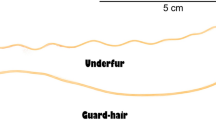Abstract
Here we present methods for distinguishing tail hairs of African elephants (Loxodonta africana), Asian elephants (Elephas maximus), and giraffes (Giraffa camelopardalis) from forensic contexts. Such hairs are commonly used to manufacture jewelry artifacts that are often sold illegally in the international wildlife trade. Tail hairs from these three species are easily confused macroscopically, and morphological methods for distinguishing African and Asian tail hairs have not been published. We used cross section analysis and light microscopy to analyze the tail hair morphology of 18 individual African elephants, 18 Asian elephants, and 40 giraffes. We found that cross-sectional shape, pigment placement, and pigment density are useful morphological features for distinguishing the three species. These observations provide wildlife forensic scientists with an important analytical tool for enforcing legislation and international treaties regulating the trade in elephant parts.





Similar content being viewed by others
References
Espinoza EO, Baker BW, Moores TD, Voin D. Forensic identification of elephant and giraffe hair artifacts using HATR FTIR spectroscopy and discriminant analysis. Endangered Species Res. 2008;9:239–46.
Leeuwenhoek Mr. Microscopical observations from Mr. Leeuwenhoeck, about blood, milk, bones, the brain, spittle, cuticula, sweat, fatt, teares; communicated in two letters to the publisher. Phil Trans 1674;(1665–1678)9:121–31.
Van Zuylen J. The microscopes of Antoni van Leeuwenhoek. J Microsc. 1981;121:309–28.
Shoshani J, et al. On the dissection of a female Asian elephant (Elephas maximus maximus Linnaeus, 1758) and data from other elephants. Elephant. 1982;2:3–93.
Freeman RA. The famous cases of Dr. Thorndyke: thirty-seven of his criminal investigations, Part 2. Kessinger Publishing; 2004.
Lochte T. Das mikroskopische bild des giraffen hares. Zool Garten. 1952;9:204–6.
Smith F. The histology of the skin of the elephant. J Anat Physiol. 1890;24:493–503.
Neuville MH. Du tégument des proboscidiens. Bull Mus Hist Nat Paris. 1917;23:374–87.
Hausman LA. Structural characteristics of the hair of mammals. Am Nat. 1920;54:496–523.
Lochte T. Atlas der Menschlichen und Tierischen Haare. Germany: Leipzig; 1938.
Buys D, Hillary JK. Notes on the microstructure of hair of the Orycteropodidae, Elephantidae, Equidae, Suidae and Giraffidae. S Afr J Wildl Res. 1984;14:111–9.
Cave AJE. Hairs and vibrissae in the Rhinocerotidae. J Zool. 1968;157:247–57.
Chernova OF, Tselikova TN. An atlas of mammalian hair: fine structure of overhair and hair using scanning electron microscopy. Moscow: KMK Sci Press; 2004. In Russian.
Dimond RL, Montagna W. The skin of the giraffe. Anat Rec. 1976;185:63–75.
Hammond EC, Jones C. An examination of a strand of 30,000 and 70,000 year old mammoth hair. In: Bailey GW, Bentley J, Small JA, editors. Proceedings of the 50th Annual Meeting of the Electron Microscopy Society of America, San Francisco, CA: Electron Microscopy Soc; 1992, vol 50, no 2, pp. 1100–1101.
Kranz KR. A note on the structure of tail hairs from a pygmy hippopotamus (Choeropsis liberiensis). Zoo Biol. 1982;1:237–41.
Ryder ML. Hair of the mammoth. Nature. 1974;249:190–2.
Valente A. Hair structure of the woolly mammoth, Mammuthus primigenius and the modern elephants, Elephas maximus and Loxodonta africana. J Zool. 1983;199:271–4.
Rasmussen LEL, Munger BL. The sensorineural specializations of the trunk tip (finger) of the Asian elephant, Elephas maximus. Anat Rec. 1996;246:127–34.
Roca AL, Georgiadis N, O’Brien SJ. Cyto-nuclear genomic dissociation and the African elephant species question. Q Int. 2007;169–70:4–16.
Johnson MB, Clifford SL, Goossens B, Nyakaana S, Curran B, White LJT, Wickings EJ, Bruford MW. Complex phylogeographic history of central African forest elephants and its implications for taxonomy. BMC Evol Biol. 2007;7:244.
Williams CS. A simple method for sectioning mammalian hairs for identification purposes. J Mammal. 1934;15:251–2.
Hieronymus TL, Witmer LM, Ridgely RC. Structure of white rhinoceros (Ceratotherium simum) horn investigated by x-ray computed tomography and histology with implications for growth and external form. J Morphol. 2006;267:1172–6.
Pollitt C. Anatomy and physiology of the inner hoof wall. Clin Tech Equine Prac. 2004;3:3–21.
Clement JL, Hagege R, Le Pareaux A, Carteaud JP. Ultrastructural study of the medulla of mammalian hairs. Scan Electron Microsc. 1981;3:377–82.
Sato H, Miyasaka S, Yoshino M, Seta S. Morphological comparison of the cross section of the human and animal hair shafts by scanning electron microscopy. Scan Electron Microsc. 1982;1:115–25.
Blakey PR, Lockwood P. The environment of calcified components in keratins. Calcif Tissue Res. 1968;2:361–9.
Chernova OF. Architectonics of the medulla of guard hair and its importance for identification of taxa. Doklady Biol Sci. 2001;376:81–5.
Acknowledgments
Doina Voin provided German and Russian translations of relevant literature and helped acquire the tail hairs used in this study. Laura Blount prepared the hair cross sections and mounted the hairs used in this study. Darby Morrell produced Fig. 1 and Michael Scanlan produced Fig. 4. The Sterling Evans Library at Texas A&M University was instrumental in obtaining literature. We thank Linzi Wilson-Wilde for inviting us to submit this manuscript. The findings and conclusions in this article are those of the authors and do not necessarily represent the views of the U.S. Fish and Wildlife Service.
Author information
Authors and Affiliations
Corresponding author
Rights and permissions
About this article
Cite this article
Yates, B.C., Espinoza, E.O. & Baker, B.W. Forensic species identification of elephant (Elephantidae) and giraffe (Giraffidae) tail hair using light microscopy. Forensic Sci Med Pathol 6, 165–171 (2010). https://doi.org/10.1007/s12024-010-9169-6
Accepted:
Published:
Issue Date:
DOI: https://doi.org/10.1007/s12024-010-9169-6




